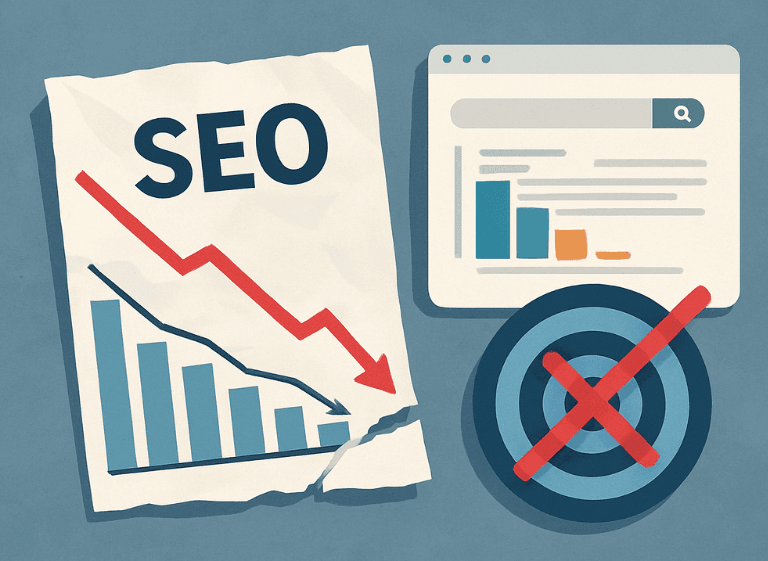SEO
Marketing strategies
Data analytics
UI/UX Design
Why SEO Strategies Fail in 2025: Aligning Goals with User Intent
Nadiia Sidenko
2025-04-25
Every year, businesses invest in SEO strategies hoping for a boost in visibility, traffic, and ultimately — revenue. Yet in 2025, many SEO strategies still fail, despite advanced tools and techniques. Why? Because they often neglect one crucial element: aligning business objectives with user intent. Understanding how people search — and why — is now essential to crafting SEO that delivers results.

SEO strategy mistakes: why business goals must come first
SEO should never operate in isolation. It's a business tool, not a magic trick. However, many campaigns begin with vague goals like “rank higher for X keyword” — without asking if that keyword aligns with what the business actually offers or what users need. As explained in What is SEO website optimization and why is it needed, foundational SEO focuses on structure and visibility, but real success starts with strategy.
Common SEO goals that often conflict with business objectives
Ranking for broad, competitive terms may seem impressive, but if they don’t drive relevant traffic or lead to conversions, what’s the point? A B2B software firm, for instance, shouldn’t chase “best free apps” just to generate clicks — it should optimize for queries tied to decision-stage buyers.
Why ignoring business KPIs leads to failed SEO campaigns
Traffic isn’t a KPI — leads, conversions, and ROI are. SEO should reflect key business metrics. Strategies not anchored in measurable business outcomes fail to justify investment and, eventually, get scrapped.
What is search intent in SEO and why it matters for rankings
Search intent is the reason behind a query. It tells you not just what users type, but what they truly want. While SEO vs SEM explains the differences in approach, both disciplines rely heavily on identifying and matching user intent.
Definition of search intent: informational, navigational, transactional
There are three primary types of intent:
- Informational: The user wants to learn (e.g. “how to improve website speed”).
- Navigational: The user wants to find a specific brand or product (e.g. “Pinta WebWare blog”).
- Transactional: The user wants to act — to buy, book, or download.
As Moz explains, recognizing these categories helps businesses produce content that satisfies not just queries, but expectations.
How Google’s algorithms evaluate search intent in 2025
In 2025, Google’s machine learning models better understand nuance, synonyms, and user context. This means websites that match the intent behind a query — not just the keywords — rank higher.
How misaligned SEO strategies destroy online growth
When SEO focuses on keywords instead of why users search, the result is disjointed traffic and wasted effort. Campaigns that ignore intent fail to drive engagement, loyalty, or conversion.
As shown in Ahrefs research, failing to match content to intent is one of the most common and costly SEO mistakes today.
Real-world examples of SEO failures caused by wrong intent targeting
- A real estate agency blogging about “home decor trends” sees traffic spikes — but zero new clients.
- An enterprise SaaS company ranking for “free CRM tools” draws students, not decision-makers.
Why traffic without relevance is a dead investment
Low-conversion traffic inflates vanity metrics but does nothing for your business. Worse — it wastes crawl budget and undermines SEO credibility.
Types of search intent: informational, navigational, transactional
Recognizing search intent should shape not only content, but also format, CTAs, and placement. Moz outlines how each type influences how users interact with a page.
Mapping user intent to content types: blog posts, landing pages, product pages
Here’s how different types of intent correlate with user behavior, content formats, and measurable business outcomes:
| Search Intent Type | User Query Examples | Best Content Format | Key Business Goal |
|---|---|---|---|
| Informational | “How to optimize a landing page” | Blog post, guide, explainer video | Brand awareness, top-of-funnel |
| Navigational | “Pinta WebWare case studies” | Homepage, company subpages | Direct engagement, trust building |
| Transactional | “Order custom logistics software” | Product/service page, contact form | Lead generation, conversions |
This matrix helps determine not only what content to create, but also why and for whom — so you’re not guessing what your audience needs.
How to prioritize content creation based on intent
Start by auditing your keyword portfolio. Which terms have transactional value? Which match your funnel stages? Use this insight to restructure or reprioritize your content roadmap.
How to align SEO content with business objectives and user needs
Your content should bridge what users want with what your business offers. It’s not enough to rank — you must resonate. According to SEMrush, intent-matching content drives significantly more qualified traffic and engagement.
Frameworks for integrating business goals into SEO planning
Use a Venn diagram approach:
- Circle 1: Business goals (revenue, lead generation, demo requests)
- Circle 2: Audience needs (education, comparison, solution)
SEO opportunities live in the intersection.
Examples of content alignment with business KPIs
- A cybersecurity firm targeting “GDPR compliance checklist” aligns with leads needing compliance solutions.
- A logistics SaaS optimizing for “real-time inventory automation” speaks directly to enterprise pain points.
2025 SEO trends: semantic search, AI, and personalized results
The SEO landscape is evolving fast. In 2025, semantic algorithms and personalized experiences change how users find and trust content.
Backlinko highlights how AI systems no longer just match words — they understand topics, tone, and context.
How semantic search changes keyword research
It’s no longer about stuffing exact phrases. Clustering topics, using synonyms, and creating context-rich content is how you optimize in 2025.
Personalization and AI: impact on content strategies
Google tailors results to past behavior, device, and location. This means SEO strategies must now include user segmentation and UX factors like speed, design, and accessibility.

Conclusion
Why SEO requires business-driven strategies in 2025
SEO without strategy is like sailing without a compass. Keywords, links, and rankings mean little unless they help achieve business goals. In 2025, the gap between what businesses say and what users search for is the difference between success and failure.
Checklist: key questions to validate your SEO strategy
- Does each target keyword match a business goal?
- Does your content satisfy real user intent?
- Are your KPIs tied to performance, not just traffic?
When to seek expert help for strategic SEO planning
When the traffic is there but conversions aren't, when rankings plateau, or when internal resources fall short — it's time to partner with those who understand how to align technical SEO with strategic goals.
SEO in 2025 isn’t just about visibility — it’s about viability.
Bridging the gap between user intent and business strategy takes data, nuance, and deep expertise. If you’re not sure where your SEO is heading, Pinta WebWare is here to guide you through. With proven cases and tailored strategies, we help turn traffic into traction.